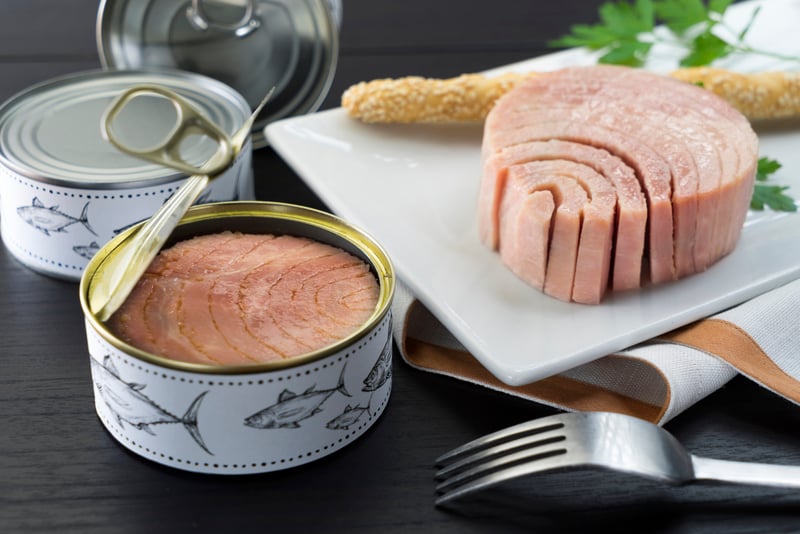Ask the Coaches: Is Canned Fish a Good Source of Omega-3?

—Cheryl
A: Cheryl, what a great question! And I’m so glad you mentioned Coach C’s Clam Chowder. How yummy is that?! I think a lot of people are a lot like you and wonder whether canned seafood is a healthy option. After all, canned seafood can be so much more convenient, especially if you don’t live near a coast.
So, is canned fish good for you? Both canned and fresh fish are great sources of protein and a number of other nutrients, including those important healthy fats you mentioned. Fortunately, the USDA has found that both fresh and canned fish have comparable amounts of omega-3 fatty acids. In fact, canned pink and red salmon have slightly more than fresh.
Just make sure you’re reaching for the wild-caught salmon rather than farmed as it contains less mercury, pesticides, and PCBs among other harmful contaminants. And grab the salmon that’s packed in water rather than oil. Not only is canned salmon just as healthy, it’s also often more affordable. In addition to using it to make salmon cakes, it also works well as burgers and on salads.
Canned crab meat is also a great lean source of protein with a good dose of healthy vitamins and minerals like vitamin B12, phosphorus, selenium, vitamin B6, calcium, zinc, and copper. It’s also low in calories and works well in a variety of recipes because of its fairly mild flavor.
In addition to crab cakes, you can add it to green salads, use it instead of tuna for a creamy crab salad made with Greek yogurt, or even in tacos. Keep in mind, however, that crab is not a top source of omega-3 fatty acids (with only about 150 mg per 3-ounce portion). So, if you’re ramping up your seafood consumption for this reason alone, this is not your best option.
Canned clams, while high in protein and rich in minerals like iron, potassium, and phosphorus, are also not known for their omega-3 content (only 160 mg per 3-ounce portion). Contrast that with canned salmon, which packs about 1,200 mg EPA and DHA per 3-ounce portion or oysters, which are another good choice of canned seafood and boast about 416 mg of EPA and DHA in 3 ounces.
Due to increased awareness of mercury poisoning and environmental sustainability, canned tuna isn’t as popular as it once was; however, water-packed tuna can still be a good choice on occasion. It should, however, be avoided by pregnant women and young children due to the risk of mercury poisoning.
What are the Best Canned Fish to Eat?
When it comes to canned fish, two overlooked superstars are mackerel and sardines. A 3-ounce portion of mackerel packs 1,134 mg of EPA and DHA. What’s more, mackerel is low in mercury and is at very low risk of being overfished.
On the other hand, you have sardines, which contain over 800 mg of EPA and DHA per 3-ounce portion. Sardines are also one of the most sustainably sourced options, and they rife with vitamin B12, selenium, vitamin D, iodine, and choline—mission-critical nutrients which many people are missing out on.
Of course, we’ve saved the best for last: anchovies. They may not sound the most appetizing, but if you’re after omega-3s, with nearly 1,800 mg per 3-ounce portion, anchovies top the list. While I wouldn’t expect you to eat them straight out of the can, anchovies can add incredible flavor to a variety of recipes, dressings, marinades, and salads. You may just have to mince them up so you can’t see them. If you’re feeling brave, simply do a search for “paleo anchovy recipes,” and you’ll discovery miracle sauces, creamy “pastas,” dips, dressings, and more!
Cheryl, as you know, omega-3 fatty acids are such an important part of a healthy diet. They’ve been shown to help:
- Decrease the risk of heart disease
- Reduce symptoms of metabolic syndrome
- Support the body’s healthy response to inflammation
- Promote brain health
- Fight depression
- Reduce anxiety
- Improve eye health
- Improve bone and joint health
- Improve sleep
- Support skin health
- And more
That’s why experts and health organizations, such as the American Heart Associations, recommend consuming at least two 3 ½-ounce servings of oily fish each week. And with the above canned options, you’ll have a variety of choices to fit your tastes and lifestyle.






